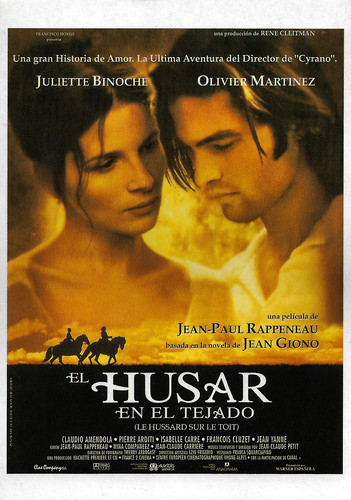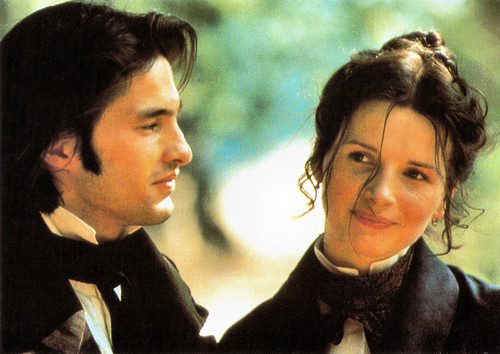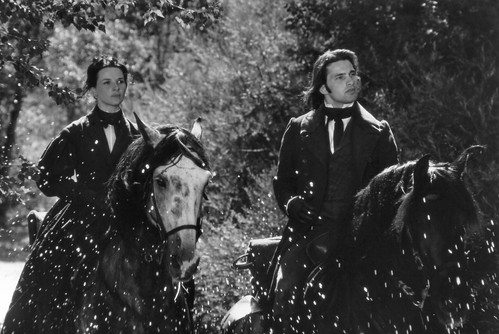
Spanish postcard by Memory Card, no 324. Image: Warner Espanola. Spanish poster of Juliette Binoche and Olivier Martinez in Le hussard sur le toit/The Horseman on the Roof (Jean-Paul Rappeneau, 1995). Spanish title is 'El husar en el tejado'.

Danish postcard by Go Card, no. 2194, 1996. Photo: Camera Film. Juliette Binoche and Olivier Martinez in Le hussard sur le toit/The Horseman on the Roof (Jean-Paul Rappeneau, 1995).
A young Italian nobleman in France raising money for the Italian revolution
In 1832, cholera ravages Provence (South of France). Italian patriots hiding out in Aix, France, are betrayed by one of their own, and Austrian agents are on their trail. One patriot, Giacomo, is dragged away and executed. His wife runs off to warn their friend, Angelo Pardi (Olivier Martinez), a young Italian nobleman in France raising money for the Italian revolution against the Austrian Empire. As the agents descend on his apartment, Angelo escapes into the countryside.
At Meyrargues, Angelo looks for his compatriot and childhood friend, Maggionari, and then continues on to another village, where he writes to his mother, "Always fleeing. When can I fight and show what your son can do?" His mother purchased his commission as a colonel in the Piedmont Hussars, and he's never seen battle. Angelo encounters Maggionari, who turns out to be the traitor. When the Austrian agents arrive, Angelo fights them off and escapes.
The next day, Angelo enters a village ravaged by a cholera epidemic. The sight of the corpses abandoned to the scavenging crows sickens him. He meets a country physician, who shows him how to treat cholera victims by vigorously rubbing alcohol on the skin. Angelo continues north, passing a small village where corpses are being burned. He meets a young woman and two children and accompanies them to the outskirts of Manosque. The young woman, who is a tutor and lover of books, gives him a copy of 'Rinaldo and Armida' as a parting gift.
While in Manosque, Angelo is captured by a paranoid mob who accuse him of poisoning the town fountain. He is taken to the authorities, who soon abandon their posts in fear. Angelo searches for a compatriot but encounters the Austrian agents. Angelo eludes them, and with a sword in hand, fights his way through the hysterical mob and escapes across the rooftops. From his refuge above the town, Angelo watches one of the agents chased down and beaten to death, and later watches the piles of corpses being burned in the night.
To escape the rain, Angelo enters a dwelling where he is discovered by Countess Pauline de Théus (Juliette Binoche). Apologising for his presence, Angelo reassures her that he is a gentleman. Pauline offers him food and drink, and soon he falls asleep from exhaustion. The following morning, Pauline is gone and Angelo joins the forced evacuation of the town. In the hills outside Manosque, Angelo meets his compatriot, Giuseppe, who possesses money raised for the Italian resistance, but which cannot now be delivered because of the quarantine and roadblocks. Angelo agrees to deliver the money to Milan using backroads. Before leaving, he encounters the traitor, Maggionari, who attempts to kill Angelo before succumbing to cholera.
Angelo and Pauline meet again, and she joins him in a daring river escape. At Les Mées, rather than head east toward the Italian border, Angelo accompanies Pauline north toward her castle near Gap. Angelo insists it is his duty, so they set off through the countryside, avoiding the plague-ridden towns. Forced to camp out in the open, romantic feelings develop between the two, but Angelo remains gallant. Asked if he comes from a military family, Angelo reveals he never knew his father, saying, "He came to Italy with Napoleon, then left." Everything he learned in life came from his mother...

French postcard by CEC Rhone-Alpes. Photo: Mario Tursi. Juliette Binoche in Le hussard sur le toit/The Horseman on the Roof (Jean-Paul Rappeneau, 1995).

Vintage photo. Juliette Binoche and Olivier Martinez in Le hussard sur le toit/The Horseman on the Roof (Jean-Paul Rappeneau, 1995).
A rousing romantic epic about beautiful people having thrilling adventures
Le hussard sur le toit/The Horseman on the Roof (Jean-Paul Rappeneau, 1995) is a beautifully mounted historical drama. Reportedly, it was the most expensive French production ever made at the time of its release. Le Hussard Sur Le Toit was nominated for ten Cesar Awards, also known as the French Oscar. The film won two of them, Best Sound (Pierre Gamet, Jean Goudier and Dominique Hennequin) and Best Cinematography (Thierry Arbogast).
American critic Roger Ebert loved the film: "The Horseman on the Roof is a rousing romantic epic about beautiful people having thrilling adventures in breathtaking landscapes. Hollywood is too sophisticated (or too jaded) to make movies like this anymore; it comes from France, billed as the most expensive movie in French history. It's a grand entertainment, intelligently written, well-researched, set in the midst of a 19th-century cholera epidemic. (...) it satisfies an old hunger among moviegoers: It is pure cinema, made of action, beauty, landscape and passion, all played with gusto, and affection."
Incredibly handsome Oliver Martinez, as the hero, was at the time a new leading man in the style of the young Jean-Paul Belmondo, who starred in films like Cartouche. Binoche played a woman loyal to her husband, for whom duty is a higher calling than passion. Roger Ebert: "Her reserve, and the instinctive chivalry of Angelo, create a sexual tension between them that is more interesting because it is not acted upon. Their restraint sets the stage for an eventual development all the more romantic because it is based on love and faith, not carnal satisfaction."
Director Jean-Paul Rappeneau started out in film as an assistant and screenwriter collaborating with Louis Malle on Zazie dans le métro/Zazie in the Metro in 1960. In 1964, he was co-screenwriter for L'Homme de Rio/That Man from Rio (Philippe de Broca, 1964), which starred Jean-Paul Belmondo. The first film that he both wrote and directed was La Vie de château/A Matter of Resistance (Jean-Paul Rappeneau, 1966) starring Catherine Deneuve.
Since 1975, Rappeneau has written only for his own films, including Le Sauvage/Lovers Like Us (1975), starring Yves Montand and Catherine Deneuve, and Tout feu, tout flamme/All Fired Up (1981), again with Montand, who co-starred with Isabelle Adjani. In 1990, Rappeneau directed an elaborate and very successful film version of Cyrano de Bergerac, his adaptation of the classic French play by Edmond Rostand, starring Gérard Depardieu. Another success was his comedy Bon voyage (2003), which again starred Depardieu with Isabelle Adjani.

French postcard by Sonis, no. C. 561 Photo: Hachette Premiere / Mario Tursi / Le Moult. Olivier Martinez and Juliette Binoche in Le hussard sur le toit/The Horseman on the Roof (Jean-Paul Rappeneau, 1995).

French postcard by Sonis, no. C. 562 Photo: Hachette Premiere / Mario Tursi, Fabian / Le Moult. Olivier Martinez and Juliette Binoche in Le hussard sur le toit/The Horseman on the Roof (Jean-Paul Rappeneau, 1995).

French postcard by Sonis, no. C. 563. Photo: Hachette Premiere / Hans Silvester, Rapho / Le Moult. Juliette Binoche and Olivier Martinez in Le hussard sur le toit/The Horseman on the Roof (Jean-Paul Rappeneau, 1995).
Sources: Roger Ebert (RogerEbert.Com), Mark Deming (AllMovie), Wikipedia (English and French) and IMDb.
No comments:
Post a Comment